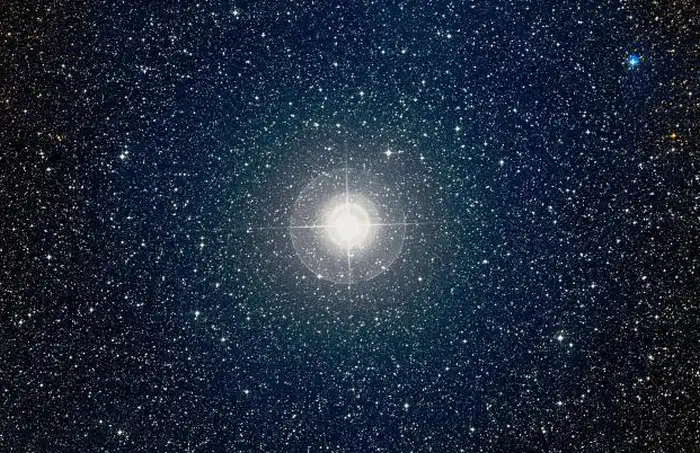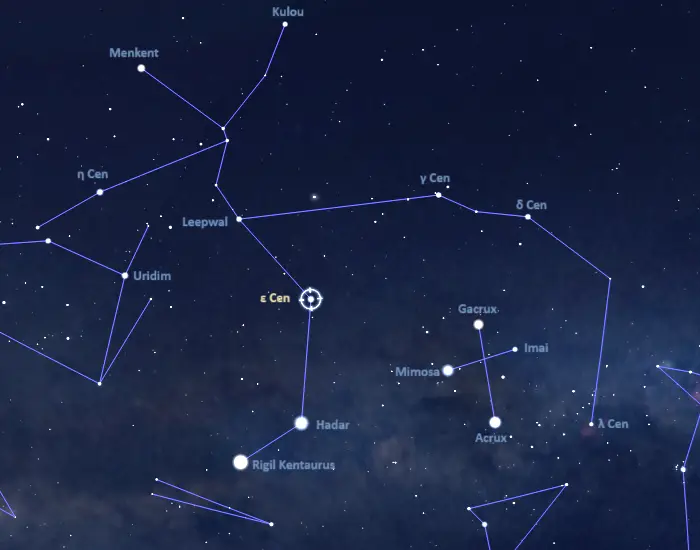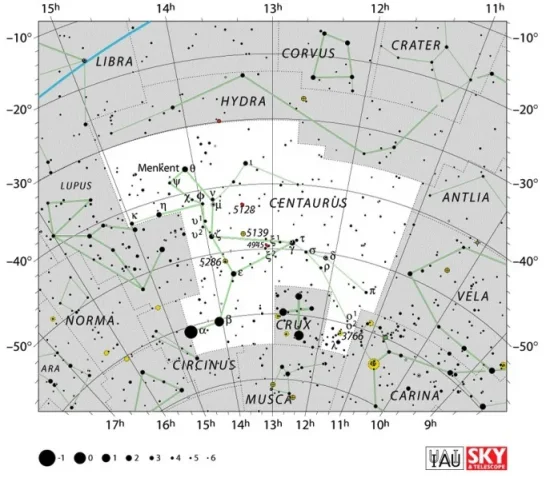Epsilon Centauri (ε Cen) is a hot blue giant star located 430 light years away in the southern constellation of Centaurus. With an apparent magnitude of 2.30, it is the fifth brightest star in Centaurus. The massive, evolved star appears in the same region as the Southern Pointers, Alpha and Beta Centauri (Rigil Kentaurus and Hadar).
Star type
Epsilon Centauri is an evolved blue giant star of the spectral type B1 III. With a mass 11.60 times that of the Sun, the star is a supernova candidate. With an effective temperature of 24,000 K, it is 15,217 times more luminous than the Sun. It has an estimated age of only about 15.8 million years. Even though it is still a very young star, Epsilon Centauri has evolved away from the main sequence quickly due to its high mass and it will not be long before it goes out as a luminous supernova.
Epsilon Centauri is a fast spinner. It has a projected rotational velocity of 160 km/s. The star is classified as a Beta Cephei variable. Its brightness has been reported to vary between magnitude 2.29 and 2.31 with a period of 0.16961 days (4 hours and 4 minutes). It completes 5.9 cycles per day.
Beta Cephei variables (or Beta Canis Majoris variables) are hot, massive, evolved B-type stars whose brightness varies due to pulsations. These stars show small and rapid brightness variations with amplitudes of 0.01 to 0.03 magnitudes. The brightest members of the class include Hadar (Beta Centauri) in the constellation Centaurus, Mimosa (Beta Crucis) in Crux, Shaula (Lambda Scorpii) and Kappa Scorpii in Scorpius, Mirzam (Beta Canis Majoris) in Canis Major, and Uridim (Alpha Lupi) in Lupus.

Epsilon Centauri, image credit: ESO/Digitized Sky Survey 2 (CC BY 4.0)
Facts
Shining at magnitude 2.30, Epsilon Centauri is the fifth brightest star in Centaurus and, on average, the 75th brightest star in the sky. It is only slightly fainter than Eltanin in the constellation Draco, Mintaka in Orion and Caph in Cassiopeia. It is about as bright as Dschubba and Larawag in Scorpius and Uridim in Lupus. The star just outshines its Centaurus neighbour Eta Centauri, Merak in Ursa Major, and Izar in Boötes.
Epsilon Centauri is a member of the Lower Centaurus-Crux subgroup of the Scorpius-Centaurus OB association (Sco OB2). The stellar association is the nearest young OB association to the Sun. The hot blue members of the group formed in the same molecular cloud and share a common motion through space. The brightest members of Sco OB2 include Antares in the constellation Scorpius, Acrux and Mimosa in Crux, Hadar in Centaurus, and Zeta Ophiuchi in Ophiuchus.
Epsilon Centauri has a visual companion at a separation of 39 arcseconds. The companion is a 13th magnitude star. If it lies at a similar distance as Epsilon Centauri, it is a K-type star. The two stars are probably not related and just lie in the same line of sight.
Name
Epsilon Centauri does not have a proper name formally approved by the International Astronomical Union (IAU). It is one of the brightest stars without a formal name, along with Gamma Velorum in the constellation Vela, Gamma Cassiopeiae in Cassiopeia, and Gamma Centauri in Centaurus.
In old Chinese astronomy, Epsilon Centauri was known as 南門一 (Nán Mén yī), the First Star of Southern Gate. It formed the Southern Gate asterism with the brighter Rigil Kentaurus (Alpha Centauri). The asterism was part of the larger Horn mansion, which represented the horns of the Azure Dragon.
Location
Epsilon Centauri lies in the far southern sky, in the same area as the brighter Alpha and Beta Centauri and the stars of the Southern Cross. It is the nearest bright Centaurus star to the Southern Pointers, Rigil Kentaurus and Hadar.
At declination -53° 27’, Epsilon Centauri never rises for observers north of the latitude 36° N and is best seen from the southern hemisphere.

Epsilon Centauri location, image: Stellarium
Constellation
Epsilon Centauri is located in the constellation Centaurus. Representing a centaur in Greek mythology, Centaurus is one of the ancient constellations listed by the Greek astronomer Claudius Ptolemy in his Almagest in the 2nd century CE. It is the ninth largest of the modern 88 constellations. It stretches across 1,060 square degrees of the southern sky.
Centaurus is best-known for being home to Alpha Centauri, the nearest star system to the Sun and the third brightest stellar point of light in the night sky, after Sirius and Canopus. Proxima Centauri, the faintest component of the Alpha Centauri system, is the closest individual star to Earth. The red dwarf lies only 4.2465 light-years away.
Hadar (Beta Centauri), the second brightest star in Centaurus, is the 11th brightest star in the sky. The hot blue giant shines at magnitude 0.61 from a distance of 361 light years and is part of a triple star system.

Centaurus constellation map by IAU and Sky&Telescope magazine (Roger Sinnott & Rick Fienberg) (CC BY 3.0)
Other notable stars in the constellation include the orange giant Menkent (Theta Centauri), the blue subgiant Leepwal (Zeta Centauri), the white main sequence star Kulou (Iota Centauri), the binary system Gamma Centauri, the chemically peculiar Przybylski’s Star, the hypergiant V766 Centauri (one of the largest stars known), and Lucy (the Diamond Star), a white dwarf believed to have a diamond core.
Bright deep sky objects in Centaurus include the massive globular cluster Omega Centauri (NGC 5139), the active galaxy Centaurus A (NGC 5128), the Running Chicken Nebula (IC 2944), the Blue Planetary Nebula (NGC 3918), the protoplanetary Boomerang Nebula, the Pearl Cluster (NGC 3766), the blue dwarf galaxy NGC 5253, the barred spiral galaxy NGC 4945, and the Backward Galaxy (NGC 4622).
The best time of the year to observe the stars and deep sky objects in Centaurus is during the month of May, when the constellation appears higher in the sky in the early evening. The entire constellation is visible from locations south of the latitude 25° S.
The 10 brightest stars in Centaurus are Alpha Centauri (mag. -0.27), Hadar (Beta Cen, mag. 0.61), Menkent (Theta Cen, mag. 2.06), Gamma Centauri (mag. 2.17), Epsilon Centauri (mag. 2.30), Eta Centauri (mag. 2.35), Leepwal (Zeta Cen, mag. 2.55), Delta Centauri (mag. 2.57), Kulou (Iota Cen, mag. 2.73), and Lambda Centauri (mag. 3.13).
Epsilon Centauri
| Spectral class | B1 III |
| Variable type | Beta Cephei |
| U-B colour index | -0.92 |
| B-V colour index | -0.22 |
| Apparent magnitude | 2.30 (2.29 – 2.31) |
| Absolute magnitude | -3.9 |
| Distance | 430 ± 30 light-years (131 ± 8 parsecs) |
| Parallax | 7.63 ± 0.48 mas/yr |
| Radial velocity | +3.0 ± 2 km/s |
| Proper motion | RA: -15.30 ± 0.36 mas/yr |
| Dec.: -11.72 ± 0.36 mas/yr | |
| Mass | 11.60 ± 1.06☉ |
| Luminosity | 15,217 L☉ |
| Temperature | 24,000 K |
| Metallicity | -0.14 ± 0.10 dex |
| Age | 15.8 ± 5.7 million years |
| Rotational velocity | 160 km/s |
| Surface gravity | 3.68 cgs |
| Constellation | Centaurus |
| Right ascension | 13h 39m 53.25774s |
| Declination | −53° 27′ 59.0081″ |
| Names and designations | Epsilon Centauri, Epsilon Cen, ε Centauri, ε Cen, HD 118716, HR 5132, HIP 66657, SAO 241047, JP11 2411, FK5 504, CP−52 6655, CPD-52 6655, CPC 19 5136, CD-52 5743, CEL 4275, CSI-52 6655 41, SKY# 25117, GC 18458, GCRV 8073, GSC 08663-02929, N30 3113, ROT 7271, PPM 342130, GEN# +1.00118716, EUVE J1339-53.4, AKARI-IRC-V1 J1339532-532759, SACS 296, 1RXS J133952.7-532745, uvby98 100118716, IRAS 13366-5312, 2MASS J13395324-5327590, TYC 8663-2929-1, TIC 241398115, UBV 12227, UBV M 19592, WEB 11756, ALS 14981, CCDM J13399-5328A, IDS 13335-5257 A, WDS J13399-5328A |